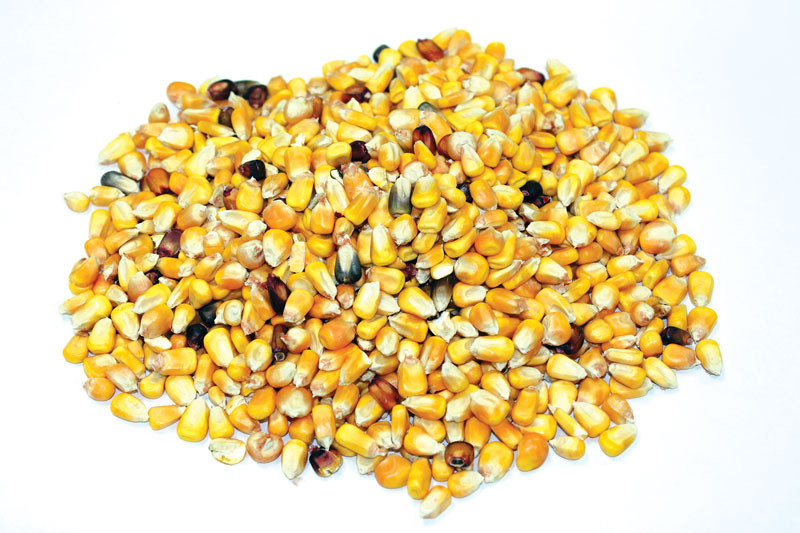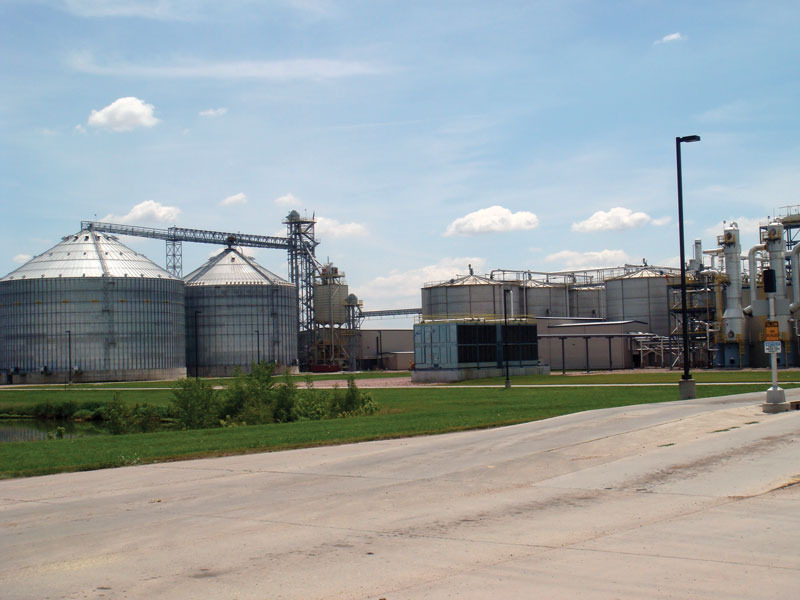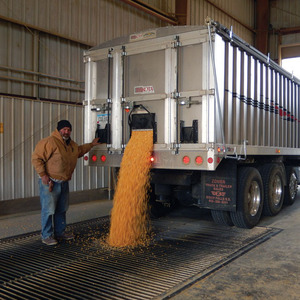New Corn Traits Yield Homegrown Enzymes




PHOTO: SYNGENTA
July 20, 2015
BY Tim Tierney
Ethanol plants are constantly looking for opportunities to increase efficiency. Sourcing alpha amylase enzyme directly from area corn growers and working with them to enhance grain quality is not only helping Plymouth Energy be more efficient, it’s helping make ethanol more sustainable.
In 2013, a desire to increase yield and throughput, and decrease energy usage led the Merrill, Iowa-based ethanol producer to enter into a commercial agreement with Syngenta for use of Enogen corn enzyme technology. It began with a two-month trial of Enogen corn and a baseline evaluation.
“We were excited at the potential benefits we believed Enogen could bring to our operation,” says Eamonn Byrne, CEO of Plymouth Energy. “Key performance indicators for us included viscosity, fermentation performance and ethanol drop concentration. The key to these plants is very simple, the more you can get through them, the more money you make, once things are profitable. Everybody is looking at ways of trying to improve efficiency. The other thing we’d been looking at for a long time was yield enhancement. Obviously, if you can get more gallons out of the same bushel of corn, that adds to your profitability as well.”
Reduced Viscosity
During the trial at Plymouth Energy, Enogen grain was metered into the cook system. Liquid alpha amylase was shut off and viscosity measured. A 40 to 50 percent decrease in viscosity was noted after only 12 hours. This viscosity reduction converted the corn mash from a consistency resembling oatmeal into one more like water, ultimately requiring less energy to pump mash through the plant, and causing less wear and tear on plant equipment. In fact, during the trial, natural gas usage decreased by 9 percent, offering the potential for significant cost savings.
“We have seen a huge difference in viscosity,” says Nathan Hesse, plant manager. “We’ve observed an increase in yield due to the ability to increase our solids. The plant runs a lot quieter today and we have more operational flexibility. In fact, increased flexibility and the freedom to operate between ranges is one of the benefits I appreciate the most. The viscosity break is so great and there’s so much freedom around that. We can run without a mixer. We can run with higher solids. I can speed up or slow down fermentation. I would have a hard time going back to traditional alpha. Plus, keeping the enzyme dollars at home definitely helps the community.”
Compared to baseline data collected, Enogen showed a 2 percent increase in yield. Plymouth Energy showed an increase in production of approximately 12 percent per day in ethanol production over baseline data conditions. These results were proven even while the average beer feed rates for production remained the same between the baseline phase of the trial and the performance run phase.
“The decrease in energy usage was pretty dramatic,” Byrne adds. “You don’t need as much electricity to push a less viscous product around your plant because you’re jumping your solids from 32 to 34, or 35—an almost 10 percent increase. “These types of improvements help make ethanol more sustainable. We saw a reduction in greenhouse gas emissions from a plant that was already very efficient. It reduced them more. You’re using less natural gas per gallon of ethanol produced, and less electricity per gallon and you’re basically putting an extra 10 percent of product through the same fixed overhead, obviously that’s going to make it more efficient from a greenhouse gas perspective and make the product ultimately more sustainable,” he says.
Simplifying Grain Tracking
Enogen was introduced in 2011 and Syngenta estimates that, in 2015, nearly 1,000 growers will plant it on approximately 225,000 acres in 10 states. Currently, nine plants have contracted Enogen corn and now either use, or plan to use, Enogen grain to produce ethanol.
Enogen growers are required to follow stewardship guidelines which include planting non-Enogen border rows around an Enogen cornfield, cleaning out planters and combines, and dedicating bin space for all Enogen grain. To simplify grain tracking, Syngenta introduced a new tool this year. The Enogen Value Tracker—a naturally derived, nongenetically modified purple tracer trait—will be included in select bags of Enogen hybrids.
According to Jack Bernens, head of Enogen at Syngenta, this stewardship innovation will help reduce the chance of misdirecting Enogen grain. “Since the introduction of Enogen corn enzyme technology in 2011, Syngenta has voluntarily implemented comprehensive stewardship protocols to mitigate potential commercial concerns about Enogen corn affecting unintended processes,” Bernens says. “The Enogen Value Tracker offers growers a way to help make this simple, effective protocol even easier.”
Bernens adds that it’s important to note that the new tracker seed does not contain Enogen corn enzyme technology. Enogen seed bags containing the tracker will include a physical mixture of approximately 95 percent Enogen seed and 5 percent Enogen Value Tracker seed to aid quick and easy identification. The Enogen Value Tracker will appear as randomly dispersed purple plants across an Enogen field (inside the border rows) and will represent up to 5 percent of the plants in a given field. The grain produced from these purple plants will be comprised of both yellow and purple kernels to make for easy visual tracking of Enogen corn from harvest through storage and processing, helping to ensure this high value grain is delivered to its intended destination. The Enogen Value Tracker is part of an ongoing Syngenta commitment to providing Enogen corn enzyme technology to the market in a manner that offers benefits to growers, ethanol plants and biofuels production, while respecting the other uses of the corn crop.
According to Byrne, corn growers and ethanol plants will appreciate the Enogen Value Tracker and the opportunity to simplify the grain tracking it provides. “We have a very strong stewardship program in place,” he says. “The Enogen Value Tracker is another step to help ensure the integrity of the process. This new tool will give everyone comfort in helping to direct the correct grain to the correct system.”
Enhancing Grain Quality
Corn feedstock is the single biggest input cost for an ethanol plant, and ethanol yield per bushel is one of the biggest drivers of plant profitability. Higher grain quality means higher ethanol yield per bushel. Chris Tingle, head of Enogen marketing at Syngenta, says ethanol plants are increasingly seeking not just clean, dry corn, with little or no damage and foreign material, but also grain with quality characteristics that can help maximize ethanol production. “A growing demand for high quality feedstock is creating opportunities for plants and growers to work together to increase grain quality,” he says. “By supplying the quality grain that ethanol plants want—all year long—growers can maximize profitability while helping ethanol plants increase efficiency.”
To help ethanol plants gain access to higher, more consistent quality grain, Syngenta is working with Plymouth Energy and other producers to introduce the Ethanol Grain Quality Solution, a protocol designed to help increase corn yields and drive grain quality through insect control, early-season weed management, glyphosate weed resistance management and crop enhancement. The Ethanol Grain Quality Solution provides the ethanol plant and its growers more, high-quality grain, while improving grower return-on-investment. “Growers with a contract can receive an additional 10 cents per bushel premium above the current Enogen contract premium by following protocols outlined in the Ethanol Grain Quality Solution,” Tingle explains. “Plus, growers who do not have an Enogen contract, can receive 10 cents per bushel for any additional bushels of corn produced under the Ethanol Grain Quality Solution protocol, provided those bushels are delivered to the ethanol plant.”
Byrne notes that Plymouth buys approximately 80 percent of its grain directly from local farmers. “Over the past five years, the trend has definitely been from commercial elevator corn to farmer-sourced grain,” he says. “For the most part, farmer-sourced corn will always be more pure, particularly when you know your farmer. You’re getting a more consistent product and consistency is the name of the game in ethanol production.”
Author: Tim Tierney
Head, Enogen Business Accounts, Syngenta
timothy.tierney@syngenta.com
612-801-9775
Advertisement
Advertisement
Related Stories
The USDA significantly increased its estimate for 2025-’26 soybean oil use in biofuel production in its latest World Agricultural Supply and Demand Estimates report, released July 11. The outlook for soybean production was revised down.
U.S. fuel ethanol capacity fell slightly in April, while biodiesel and renewable diesel capacity held steady, according to data released by the U.S. EIA on June 30. Feedstock consumption was down when compared to the previous month.
The U.S. EPA on July 8 hosted virtual public hearing to gather input on the agency’s recently released proposed rule to set 2026 and 2027 RFS RVOs. Members of the biofuel industry were among those to offer testimony during the event.
The USDA’s Risk Management Agency is implementing multiple changes to the Camelina pilot insurance program for the 2026 and succeeding crop years. The changes will expand coverage options and provide greater flexibility for producers.
The USDA’s National Agricultural Statistics Service on June 30 released its annual Acreage report, estimating that 83.4 million acres of soybeans have been planted in the U.S. this year, down 4% when compared to 2024.
Upcoming Events










